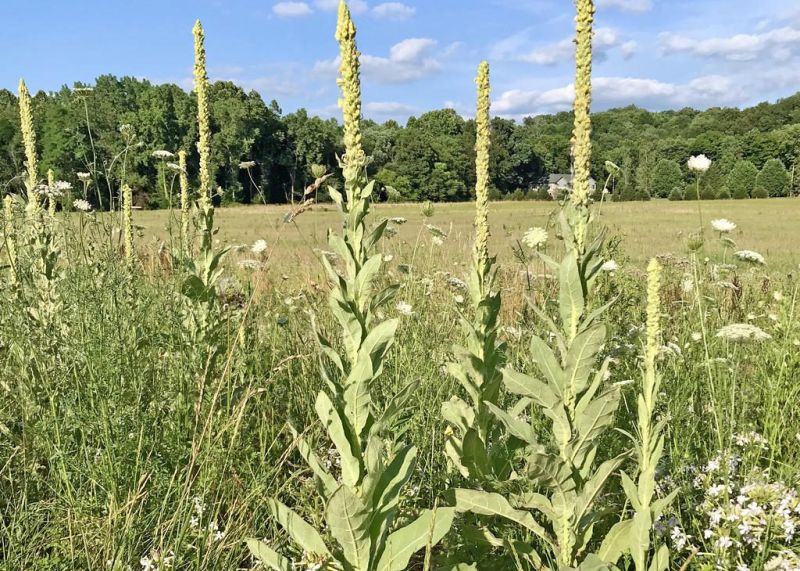An animal guy takes on cowboy toilet paper
- John Lorson: The Rail Trail Naturalist
- July 24, 2020
- 2880
I’ve admitted before on these pages that I’m not a great “plant guy.” My biology training was focused on animals, even more specifically, animals with backbones or “vertebrates.” So I can tell you a lot about a snapping turtle, beaver or wild turkey right off the top of my head.
Plants weren’t even part of my college curriculum beyond how they work. I do recall studying the entire process of photosynthesis in excruciating detail only to regurgitate it in a lengthy essay on some long-ago exam, but beyond that I was all about animals. So I’m a relative newcomer to the study of botany.
Sadly, calling my newfound interest in plants a “study” is actually being a little pretentious. At this point I am mostly a “pointer and namer,” and I learned early in my naturalist training that one must move beyond simply being able to say “that plant with the red stem is Indian hemp” and then walk on to the next point of interest.
Folks will remember things if there’s a greater story attached to it, so any extra detail might make the learning a whole lot easier, but at the same time a bit richer. So a better lesson on an encounter with Indian hemp would be to add that it’s in the same family as milkweed, and one plant can be mistaken for the other when they are young. Milkweed, however, may prove considerably more desirable for the gardener or conservationist as monarch butterfly caterpillars do not eat Indian hemp.
The plant is known by numerous other names, and dogbane might be a good one to remember as the plant is poisonous to dogs (as the name implies) and livestock as well.
The plant name game is a bit of a wild ride. Nearly all plants have, beyond their proper, scientific, “binomial nomenclature” (two Latin words name), a whole slew of colloquial names. In addition to Indian hemp and dogbane, Apocynum Cannabinum also is known in other parts of the country as wild cotton, Amy root and prairie dogbane.
One plant that has a list of common names as long as your arm is one of my favorite weeds. (I can hear the collective gasp of many of my farming friends when I declare my love for a weed. One must remember, however, that one man’s weed is another man’s wildflower.)
The common mullein (Verbascum thapsus) stands as a tribute to the idea that people all over the world have named plants whatever suited them at the time and all their friends and neighbors just went along with it.
A native of the Mediterranean region, an early name bestowed upon the mullein by the Romans was Jupiter’s staff. Because of the plant’s large, single stem that climbed straight up as tall as a man, this seems an easy call. Others have fixated on the stem as well, and various names keying on the plant as a walking stick have taken hold: Aaron’s rod, shepherd’s club — you get the picture.
Some ancients used the dried-out staff as a torch by soaking the flowering body in oil or grease, thus the names Indian torch and hag’s tapir took hold (the latter being a reference to witches lighting their way with the preparation).
Beyond the stem, the thick, furry leaves have proven even more inspirational. The plant is a biennial, and the first year a rosette of large, soft leaves radiates a foot in or more in all directions. Velvet mullein, beggar’s blanket, feltwort and flannel leaf all give a nod to the unique look and feel of the plant. A favorite among these is “bunny ears,” but then again, I am an animal guy.
As an herbal medicinal, the common mullein lays claim to dozens of beneficial uses, and various preparations of the plant have been used to treat everything from earaches to frostbite and athlete’s foot to pulmonary disease. Always consult an expert before trying any of these remedies on your own.
Finally, I’ll leave you with one common name for mullein that requires no explanation or consultation, and it might very well be one of those things that will stick in your memory forever: cowboy toilet paper. (There, now you’ve learned something undeniably useful from this column.)
Remember, if you have comments on this column or questions about the natural world, write The Rail Trail Naturalist, P.O. Box 170, Fredericksburg, OH 44627, or email Lorson at jlorson@alonovus.com.

